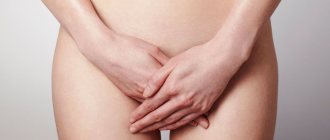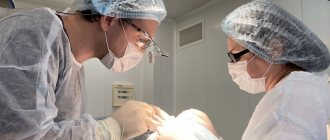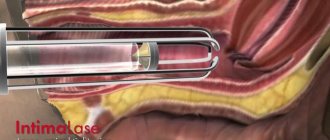How to choose a penile prosthesis?
There are hydraulic, semi-solid and solid implants. The most popular are hydraulic penile prostheses, which are comfortable, look natural and have no side effects. Two soft cylinders are implanted into the cavernous bodies of the penis, which are connected by tubes to a pump and reservoir. When you press the pump, sterile water from the reservoir fills the cylinders, making them hard, as with a natural erection.
Hydraulic prostheses come in three- and two-component types. In the latter, the pump reservoir is located in the scrotum. In three-component ones, the reservoir is placed behind the pubis, and the pressure pump is in the scrotum.
Semi-rigid implants have good mechanical strength, but are somewhat uncomfortable in everyday life. There is a risk of perforation and outward migration of the prosthesis. This penile prosthesis consists of two multilayer silicone cylinders connected to each other by silver wire.
Rigid penile prostheses are not used in modern medical centers. They are completely uncomfortable and lead to complications due to constant pressure on the tissue of the penis.
Indications
Most often, penile prosthesis is recommended to a man in cases where it is impossible to restore normal blood flow in the tissues. Indications for surgery are:
- atherosclerotic changes in the arteries and cavernous bodies of the penis,
- fibrosis and scarring of the corpora cavernosa,
- congenital anomalies of the structure of the genital organ,
- Peyronie's disease,
- impotence due to severe diabetes mellitus,
- psychogenic erectile dysfunction that cannot be corrected using conservative methods.
A man’s sexual capabilities are fully restored after penile replacement. The results last a lifetime.
We install penile prostheses from the world's leading manufacturers with a lifetime guarantee
At the Urology Clinic of the First Moscow State Medical University, implantation is performed by doctors with surgical practice of at least 10 years.
The operation is possible from two surgical approaches: through a small incision in the scrotum or pubic area. The advantages of the latter are that the risk of complications is lower and combined andrological operations are possible. For example, one-step lengthening of the penis.
The patient stays in the clinic for two days, sexual activity is possible one and a half to two months after the operation.
Recovery of a man after penile prosthesis.
Life after penile prosthesis. The first days after surgery will be the most difficult. It is for this reason that it was decided to publish an article devoted to the issue of rehabilitation of men who underwent penile prosthesis. In which I will describe in detail the general condition, complaints and sensations that most men experience in the first three days after penile prosthesis.
- FIRST DAYS after penile prosthesis. The day after surgery, the patient may feel discomfort in the perineum, scrotum and shaft of the penis. The discomfort may increase and become painful when sitting (especially on soft surfaces) or when walking.
- In order to prevent postoperative bleeding, upon completion of implantation of a three-component hydraulic implant (Coloplas or AMS), the implant is activated until the next morning.
- The first dressing after penile prosthesis involves changing the dressing and deactivating the implant (the doctor will reduce the pressure in the implant cylinders). The process may be accompanied by unpleasant and painful sensations.
- After the implant is deactivated, the doctor will remove the drainage from the scrotum. Drainage is a device that allows you to clean the surgical area from wound discharge and blood, and prevents the formation of hematomas. The removal process is almost painless.
- It is important to understand that on the first post-operative morning, any pressure on the pump (located in the scrotum) and on the cylinders of the penis (located in the shaft of the penis) will be painful or extremely unpleasant, which is normal.
- SECOND DAY after penile prosthesis. The second dressing is less painful, since no manipulation of the implant occurred. It involves treating the surgical area with an antiseptic solution and changing a sterile dressing.
- It is important to understand that on the first post-operative morning, any pressure on the pump (located in the scrotum) and on the cylinders of the penis (located in the shaft of the penis) will be painful or extremely unpleasant, which is normal.
- THIRD DAY after penile prosthesis. Pain and discomfort noticeably subside even in a sitting position and when lifting. With each subsequent day, pain symptoms will noticeably decrease until they disappear completely. Postoperative sutures will be removed on days 10-12.
- At the time of discharge, the doctor must instruct the patient in detail about how and when to activate and deactivate the implant. How and by how much to increase the duration of activation, what you need to pay attention to when resuming sexual activity.
Sexual life after penile prosthesis. Following all the specialist’s recommendations, it is possible to begin sexual activity within 1.5 months after surgical treatment. It is this nature of time that is required to restore the integrity and healing of the inner membranes of the penis. Penile prosthesis does not affect urination, orgasm, ejaculation and reproductive function of a man!
ALL ABOUT PENAL PROSTHETICS
PHOTOS OF ALL STAGES OF THE PENTAL PROSTHETICS OPERATION
APPEARANCE OF THE PENIS AFTER PENAL PROSTHETICS
Penile prosthetics
Penile prosthesis - surgical treatment of erectile dysfunction
Penile prosthesis is currently the most effective and most commonly used method of restoring penile rigidity.
Such a high efficiency of implantation of alloplastic materials into the penis is due to the analogy with such a biological phenomenon as the presence of penile bone in some mammals, as well as the reliability and perfection of the design of modern prostheses. Thanks to this, restoration of sexual function occurs in more than 90% of cases. Indications for penile prosthesis:
- vasculogenic erectile dysfunction;
- psychogenic erectile dysfunction;
- cavernous fibrosis;
- Peyronie's disease;
- ineffectiveness or patient's unacceptability of vacuum erectors or intracavernosal therapy;
- syndrome of true underdevelopment or acquired reduction of the penis;
- endocrine impotence;
- genital trauma;
- diabetes.
The main indications for implantation were vasculogenic erectile dysfunction, cavernous fibrosis, and diabetes mellitus. However, there is often a combination of the above reasons. An atypical indication is psychogenic erectile dysfunction. It is believed that such a diagnosis in itself cannot be a basis for penile prosthesis. Implantation can be performed in this group of patients only in exceptional cases, when psychogenic dysfunction cannot be corrected after multiple courses of conservative treatment.
Classification of penile prostheses
- generation – semi-rigid;
- generation - plastic;
- generation – mechanical;
- generation - inflatable.
- one-component;
- two-component;
- three-component.
The Academy VIP clinic uses semi-rigid prostheses. They are the simplest and least comfortable implants and consist of paired elastic silicone rods. They give the penis the necessary rigidity, having neither plastic memory nor variable rigidity.
Implantation of plastic prostheses also brings the penis into a state of constant erection, but their main difference and advantage lies in plastic memory, which allows you to maintain any position given to the penis. Thus, the penis has a more natural appearance while maintaining copulatory function. The plastic memory of this type of prosthesis is provided by a metal base sealed in a silicone shell.
Our clinic also uses 4th generation prostheses, called inflatable ones, which have variable stiffness and are currently the most advanced. The phenomenon of variable stiffness makes it possible to easily and simply simulate the physiological states of the penis, both at rest and during erection. This, in turn, ensures quick and complete restoration of sexual function with a good aesthetic result of the operation. Another advantage of this type of implant is that it reduces the likelihood of perforation and pressure ulcers by reducing pressure on the tissue.
In one-component prostheses, a pump, reservoir and cylinders are combined together. These systems are easy to implant, but are inconvenient for the patient to use.
In two-component prostheses, the pump is taken out separately and placed in the scrotum, which facilitates use and reduces the likelihood of complications. The surgical technique is simple, and the prosthesis itself is pre-filled and does not require preliminary preparation before the operation.
Three-component systems are considered the most physiological, since their design allows you to change not only the rigidity of the cylinders, but also increase their diameter and length. This completely simulates the various physiological conditions of the penis and contributes to the most complete sexual rehabilitation of patients. The only drawback is that the implantation technique is somewhat more complicated, but this does not significantly affect the result of the operation.
As can be seen from the above comparative assessment of various types of prostheses, there is no ideal or universal implant. The placement of various alloplastic materials into the intracavernous space is not physiological, but at the same time it is necessary to recognize that penile prosthetics is the most effective method of treating organic forms of erectile dysfunction.
Penile prosthetics (penile prosthetics)
There are 2 main types of penile prosthesis
c: inflatable and semi-rigid.
Inflatable implants (2-component and 3-component)
Three-component prostheses are the most advanced, effective and easy-to-use model of prosthesis, since thanks to the special structure of the device you can independently control your erection for the required amount of time.
Three-component implants include:
- a special fluid-filled reservoir that is placed under the abdominal wall
- two inflatable cylinders placed in the shaft of the penis
- pump with valve placed in the scrotum
To achieve an erection, pressing a valve in the scrotum forces fluid from a reservoir into the cylinders. After achieving the required erection and having sexual intercourse, you will need to drain the liquid back into the reservoir by pressing the valve again.
The two-piece model works in a similar way, but the fluid reservoir is part of a pump implanted in the scrotum.
Semi-rigid prostheses (rods)
Semi-rigid devices are always solid. Thus, the penis is always in a semi-active state. That is, to perform sexual intercourse, it is enough to simply raise the penis.
Each of the above methods has its own advantages and disadvantages. A full examination and conversation with your doctor and surgeon will help you determine the most optimal method of treating erectile dysfunction for you.
Comparison of different types of prostheses
| Prosthesis | Advantages | Flaws |
| Three-component | The most natural erection Natural position of the penis when deflating the pump | Consists of more parts, malfunctions are possible Requires placement of a reservoir in the abdominal cavity |
| Two-component | Natural position of the penis when deflating the pump | Mechanically more complex than its semi-rigid counterpart Less firm erection than its three-part counterpart |
| Semi-rigid | Reliability Ease of use | The penis is always in a semi-hard state Constant pressure on the structures of the penis - the risk of complications is higher Inconvenient to hide under clothes |
The installation of prostheses is carried out percutaneously, that is, using a small 1.5-centimeter incision on the penis near the scrotum, which is then practically invisible. Restoration of activity (including sexual activity) is possible 4-6 weeks after surgery. More precise dates should be discussed with your doctor in each specific case.
If you have any additional questions about this operation, you can contact us online or by phone indicated in the profile header, and also schedule a consultation with one of our specialists.
By choosing us, you choose experienced specialists, high-quality examination and surgical treatment according to international standards.
Before hospitalization, you can meet the staff of our department, who specialize in the surgical treatment of erectile dysfunction.
Types of penile prostheses
To restore erectile function, various types of prostheses are used.
- Semi-rigid, or elastic, have a simple one-component design. During the operation, silicone cylinders equipped with rods with plastic memory are implanted into the corpora cavernosa of the penis. To achieve an erection, a man just needs to lift his penis with his hand, and after sexual intercourse return it to its previous position. Penile prostheses of this type are not suitable for everyone, as they maintain constant rigidity.
- Hydraulic - innovative three-component designs. The structure of such prostheses includes two cylinders with a fluid reservoir. They are connected to the pump. To simulate an erection, simply press the pump so that the liquid fills the cylinders. Hydraulic prostheses are very easy to use and do not cause discomfort.
Prices for penile prosthesis in Moscow vary depending on the type of structure. The most expensive are hydraulic implants.








